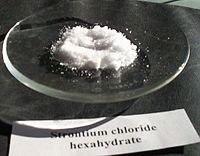| Revision as of 18:14, 19 January 2008 editTravis.Thurston (talk | contribs)Extended confirmed users, Pending changes reviewers5,641 edits rvt POV edit Undid revision 185453886 by ScienceApologist (talk)← Previous edit | Revision as of 18:57, 19 January 2008 edit undoජපස (talk | contribs)Extended confirmed users, Pending changes reviewers, Rollbackers60,484 edits Undid revision 185465116 by Travisthurston (talk) undo wikistalking reverts.Next edit → | ||
| Line 94: | Line 94: | ||
| SrCl<sub>2</sub>(]) + ](]) → SrSO<sub>4</sub>(]) + 2 ](]) | SrCl<sub>2</sub>(]) + ](]) → SrSO<sub>4</sub>(]) + 2 ](]) | ||
| Strontium chloride is occasionally used as a flame colouring agent (red) in ], and in small quantities in ] making and ]. It is added to some toothpastes to reduce ] |
Strontium chloride is occasionally used as a flame colouring agent (red) in ], and in small quantities in ] making and ]. It is added to some toothpastes to reduce ]. | ||
| The ] ] strontium-89 is usually administered in the form of strontium chloride: it is used for the treatment of ]. | The ] ] strontium-89 is usually administered in the form of strontium chloride: it is used for the treatment of ]. | ||
Revision as of 18:57, 19 January 2008
 Strontium chloride hexahydrate | |
| IUPAC name Strontium chloride | |
| General | |
|---|---|
| Molecular formula | SrCl2 |
| Molar mass | 158.53 g/mol (anhydrous)
266.62 g/mol (hexahydrate) |
| Appearance | White crystalline solid |
| CAS number | (hexahydrate)
(anhydrous) |
| MSDS | Strontium chloride MSDS |
| Other names | |
| |
| Bulk properties | |
| Density | 3.052 g/cm³ (anhydrous, monoclinic form) |
| Solubility | water: 53.8 g/100 cm³ (20 °C)
ethanol: very slightly soluble acetone: very slightly soluble |
| Melting point | 874 °C (1147 K) |
| Boiling point | 1250 °C (1520 K) |
| Hazards: | Irritant |
| Structure | |
| Coordination geometry | octahedral (six-coordinate) |
| Crystal structure | Deformed TiO2 |
| Hydrates | dihydrate (rare)
hexahydrate |
| Related compounds | |
| strontium fluoride | calcium chloride |
Strontium chloride (SrCl2) is a salt of strontium and chlorine. It is ionic and water-soluble. It is less toxic than barium chloride, though more toxic than calcium chloride. It emits a bright red colour when heated in a flame.
Chemical properties
Strontium chloride is a typical ionic metal salt, and it can be used as a source of other strontium compounds such as strontium chromate:
SrCl2(aq) + Na2CrO4(aq) → SrCrO4(s) + 2 NaCl(aq)
SrCl2 always acts as a simple salt, and it is completely neutral in solution.
Preparation
Strontium chloride can be prepared from strontium hydroxide or strontium carbonate reacting with hydrochloric acid:
Sr(OH)2(aq) + 2 HCl(aq) → SrCl2(aq) + 2 H2O(aq)
It can also be prepared by the union of the elements, strontium and chlorine.
Uses
There are no major uses for strontium chloride, though it can be used to prepare less common compounds of strontium, and may be useful in reducing gum sensitivity, and is known as Elecol for this purpose. Certain toothpastes such as Sensodyne are called "strontium chloride toothpastes," although most now use potassium nitrate instead (with the exception of Sensodyne original). Like barium chloride it can be used to test for sulfate ion, though not at such low concentration, since strontium sulfate is more soluble than barium sulfate.
SrCl2(aq) + SO4(aq) → SrSO4(s) + 2 Cl(aq)
Strontium chloride is occasionally used as a flame colouring agent (red) in pyrotechnics, and in small quantities in glass making and metallurgy. It is added to some toothpastes to reduce periodontal disease.
The radioactive isotope strontium-89 is usually administered in the form of strontium chloride: it is used for the treatment of bone cancer.
Sea water aquaria must add small amounts of strontium chloride to the water, as it is consumed in the production of the exoskeletons of certain plankton.
Precautions
Although much less toxic than barium chloride, strontium chloride should still be handled with care.